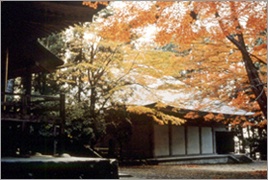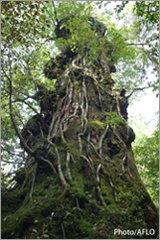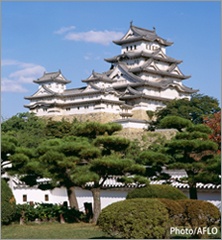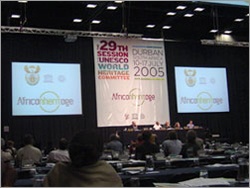Cooperation with International Organizations (UNESCO,UNU)
World Heritage
World Heritage Convention

The World Heritage Convention, properly titled the Convention concerning the Protection of the World Cultural and Natural Heritage, is a convention that protects Cultural Heritage and Natural Heritage from the threat of damage or destruction and preserves them through the establishment of a system of international cooperation and assistance. Such heritage is the legacy of all humanity.
The UNESCO General Assembly adopted this Convention in 1972. The Convention came into effect in 1975. The number of States Parties has reached 196 as of August 2024. Japan became a party to the Convention in 1992.
World Heritage
 photo/AFLO
photo/AFLO
World Heritage refers to the properties inscribed on the World Heritage List, which has been created based on the World Heritage Convention. The term can refer to three types: Cultural Heritage, such as buildings and relics; Natural Heritage, including natural areas; and Mixed Heritage which combine elements of both culture and nature.
As of August 2024, there have been 1,223 properties are inscribed on the World Heritage List (952 properties of Cultural Heritage, 231 properties of Natural Heritage, and 40 properties of Mixed Heritage), including 26 Japan's World Heritage properties (21 Cultural Heritage properties and 5 Natural Heritage properties).
Whether the heritage property nominated by one of the States Parties to the Convention will be added to the list or not is decided by the World Heritage Committee, which consists of twenty-one Member States.
Outstanding Universal Value
 photo/AFLO
photo/AFLO
Within the World Heritage Convention, World Heritage is prescribed to be that which possesses "outstanding universal value." The criteria are detailed in the Operational Guidelines for the Implementation of the World Heritage Convention, as laid down by the Committee. In addition to these criteria, preservation actions and management of the Government of the State Party of the heritage will be also examined.
The properties inscribed on the World Heritage List are globally recognized to have outstanding universal value. The preservation of each heritage is the duty of the State Party possessing the heritage, but in cases where sufficient protection cannot be provided to the property by the responsible State Party, it may apply for international assistance through the World Heritage Fund. In particular, heritage that has been placed in special and grave danger through rapid urbanization, armed conflicts, national disasters or other causes can be put on the List of World Heritage in Danger by the World Heritage Committee. Upon the inscription on the Danger List, an appeal for the urgent safeguard of the properties may be made to the international community.
World Heritage Committee

Since the acceptance of the Convention in 1992, Japan has been making various contributions to the implementation of this Convention.
Japan served as a Member State of the World Heritage Committee from 1993 (a year after the acceptance of the Convention) until 1999. During that period it also served as the Vice Chair from 1995 to 1996. In addition, in 1998 Japan hosted the 22nd session of the World Heritage Committee in Kyoto, with Matsuura Koichiro (then Ambassador to France and then Director-General of UNESCO) as the Chair. Following that, Japan served as a Member State of the World Heritage Committee from 2003 to 2007, 2011 to 2015 (Vice Chair: 2013-2014) and 2021 to 2025.
Japan’s Contribution
Japan has been a major financial contributor to the Committee. In 2023 Japan donated US$277,402 (approximately 38 million yen).
Since its adoption in 1972, the number of States Parties to the World Heritage Convention and of the inscribed properties on the World Heritage List have dramatically increased, and then various issues regarding the implementation of the Convention have been actively discussed.
In 2012, which was the 40th anniversary, numerous events and meetings were held worldwide to reflect upon the achievements and evolution in the past and discuss the present significance and the future of the Convention.
Japan held the Closing Event of the celebration of the 40th Anniversary in November in Kyoto, so that Japan impressed actively its contribution to the World Heritage Convention by presenting "the Kyoto Vision", which outlines future direction of the Convention. Commemorating the 50th anniversary of the World Heritage Convention, Ministry of Foreign Affairs, together with Agency for Cultural Affairs and Japan Consortium for International Cooperation in Cultural Heritage, hosted the symposium under the theme “50 Years of World Cultural Heritage: Past and Future of Japan’s contribution” in January 2024.
- Parliamentary Vice-Minister Ms. IKUINA’s visit to Sado City, Niigata Prefecture (November 25, 2024)
- Statement by the Japanese Delegation on the occasion of the deliberation of “Sado Island Gold Mines” at the 46th Session of the World Heritage Committee of UNESCO (July 27, 2024)
- The inscription of "Sado Island Gold Mines" on the World Heritage List (Statement by Foreign Minister KAMIKAWA Yoko) (July 27, 2024)
- Inscription of the “Sado Island Gold Mines” on the World Heritage List (Decision at the 46th Session of the World Heritage Committee of UNESCO) (July 27, 2024)
- The inscription of "Jomon Prehistoric Sites in Northern Japan" on World Heritage List (Statement by Foreign Minister MOTEGI Toshimitsu) (July 27, 2021)
- Inscription of “Jomon Prehistoric Sites in Northern Japan” on the World Heritage List (Decision at the Extended 44th Session of the World Heritage Committee) (July 27, 2021)
- The inscription of "Amami-Oshima Island, Tokunoshima Island, the Northern part of Okinawa Island and Iriomote Island" on World Heritage List (Statement by Foreign Minister MOTEGI Toshimitsu) (July 26, 2021)
- Inscription of “Amami-Oshima Island, Tokunoshima Island, the Northern part of Okinawa Island and Iriomote Island” on the World Heritage List (Decision at the Extended 44th Session of the World Heritage Committee) (July 26, 2021)
- The archives of contributions and interviews prior to 2020 are available on the website of the National Diet Library's Web Archiving Project.



